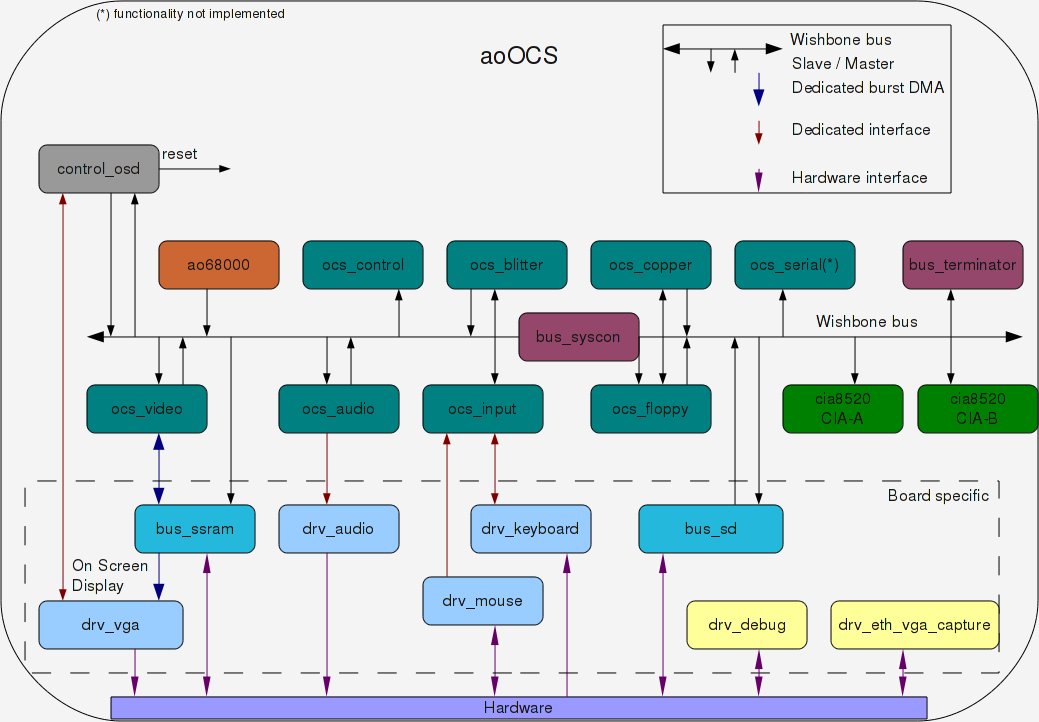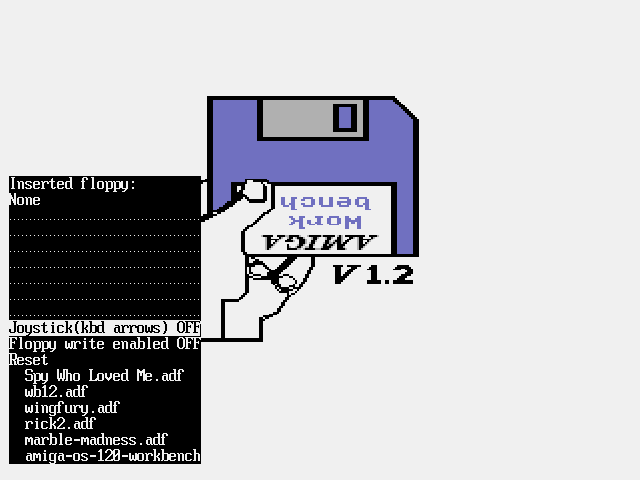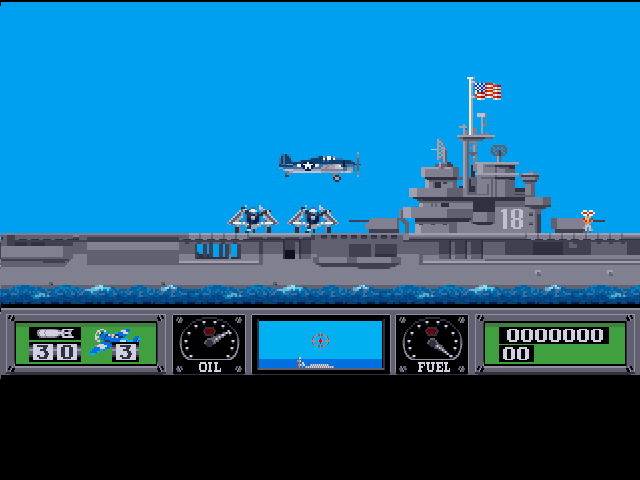aoOCS - Wishbone Amiga OCS SoC
Project maintainers
Details
Name: aoocs
Created: Dec 19, 2010
Updated: Aug 4, 2011
SVN Updated: Dec 20, 2010
SVN: Browse
Latest version: download (might take a bit to start...)
Statistics: View
Bugs: 0 reported / 0 solved
Created: Dec 19, 2010
Updated: Aug 4, 2011
SVN Updated: Dec 20, 2010
SVN: Browse
Latest version: download (might take a bit to start...)
Statistics: View
Bugs: 0 reported / 0 solved
Star2you like it: star it!
Other project properties
Category:System on Chip
Language:Verilog
Development status:Beta
Additional info:FPGA proven
WishBone compliant: Yes
WishBone version: n/a
License: BSD
Language:Verilog
Development status:Beta
Additional info:FPGA proven
WishBone compliant: Yes
WishBone version: n/a
License: BSD
Description
The OpenCores aoOCS SoC is a Wishbone compatible implementation of most of the Amiga Original Chip Set (OCS) and computer functionality.
aoOCS is not related in any way with Minimig - it is a new and independent Amiga OCS implementation.
Introduction
July 2011: Project copied to (https://github.com/alfikpl/aoOCS). Further development of aoOCS will continue on github.
Features
- The aoOCS SoC contains the following Amiga/OCS components:
- blitter
- copper
- system control (interrupts)
- video: bitplains, sprites, collision detection
- audio: 4 channels, low-pass filter
- user input: PS/2 mouse, PS/2 keyboard and joystick (keyboard arrow keys)
- floppy: read and write ADF files directly from a SD card. Only the internal floppy drive is implemented
- 8520 CIA
- ao68000 OpenCores IP core is used as the aoOCS processor
- All of the above components are WISHBONE revision B.3 compatible
- The aoOCS contains the following additional components:
- SD card controller written in HDL with DMA. Supports SDHC cards only.
- 10/100 Mbit Ethernet controller written in HDL to send the current VGA frames (frame grabber)
- HDL drivers for SSRAM, PS/2 keyboard, PS/2 mouse, audio codec, VGA DAC
- aoOCS uses only one external memory: a SSRAM with 36-bit words and pipelined access. A video buffer with about 250KB is located SSRAM. Another 256KB are used by the ROM. All the rest memory can be used as Chip RAM.
- The On-Screen-Display is implemented in HDL as a finite state machine. No additional controller/processor with firmware required to handle the SoC.
- The following options are available on the On-Screen-Display:
- select ROM file to load (only Amiga Kickstart v1.2 was tested)
- enable or disable Joystick (keyboard arrow keys)
- enable or disable floppy write protection
- insert a floppy - select one from a list
- eject an inserted floppy
- reset the system
- The On-Screen-Display is independent of the running Amiga software. It is enabled and disabled by the Home key and controled by the keyboard arrow keys and the right CTRL key.
- Only PAL timings are implemented.
- The video output is VGA compatible: 640x480 at 70 Hz. A rather simple method is used to extend the 256 PAL horizontal lines to 480 VGA lines: all lines are doubled except for every 8th one.
- The system uses generally a single clock: 30 MHz. There are two more clocks: 12 MHz, 25 MHz generated to interface with external hardware (Audio codec, Ethernet controller). A single altpll is used to generate all three clocks from one 50 MHz external clock. More information about clocks is available at Clocks.
- A VGA frame grabber is implemented that sends captured frames by 100 Mbit Ethernet in IP/UDP packets.
- The system uses about 26.400 LE on Altera Cyclone II and about 267.000 bits of on-chip RAM.
- The blitter functionality was tested against the E-UAE Amiga software emulator.
- Tested only on a Terasic DE2-70 board (www.terasic.com.tw).
- Documentation generated by Doxygen (www.doxygen.org) with doxverilog patch (http://developer.berlios.de/projects/doxverilog/). The specification is automatically extracted from the Doxygen HTML output.
WISHBONE compatibility
- Version: WISHBONE specification Revision B.3,
- General description: 32-bit WISHBONE interface,
- WISHBONE data port size: 32-bit,
- Data port granularity: 8-bits,
- Data port maximum operand size: 32-bits,
- Data transfer ordering: BIG ENDIAN,
- Data transfer sequencing: UNDEFINED,
- Constraints on
CLK_Isignal: described in Clocks.
Similar projects
Other Open-Source Amiga implementations include:
- Minimig (http://code.google.com/p/minimig/) - FPGA-based re-implementation of the original Amiga 500 hardware. Runs on the Minimig PCB and also on Terasic DE1,2 boards.
Limitations
- No filesystem support on the SD card. Data is read from fixed positions. The contents of the SD card is generated by the
aoOCS_tooldescribed at Operation. - No video external synchronize, lace mode, lightpen, genlock audio enable, color composite (BPLCON0)
- All bitplain data is fetched at once in a burst memory read at the begining of each line. No changes to the bitplain data done after the beginning of a line are visible.
- Currently aoOCS requires an 36-bit word SSRAM to store the video buffer. This way 3 pixels 12-bits each can be stored in one word.
- Serial port not implemented.
- Parallel port not implemented.
- Low-pass filter disable/enable by CIA-A port A bit 1 not implemented.
- Proportional controller and light pen not implemented.
- Some rarely used OCS registers are not implemented: strobe video sync, write beam position, coprocessor instruction fetch identify. For a complete list of not implemented registers look at Registers.
- Only some of the Amiga software was tested and works on the aoOCS. A list of aoOCS software compatability is located at Operation.
TODO
- Fix some of the above limitations.
- Optimize the design.
- Run WISHBONE verification models.
- More documentation of Verilog sources.
- Describe testing and changes done in E-UAE sources.
- Prepare scripts for VATS: run_sim -r -> regresion test.
- Port the aoOCS SoC to a Xilinx FPGA.
Status
- Amiga Workbench v1.2 runs with some minor graphic problems: bottom of screen not displayed correctly.
- Prince of Persia runs perfectly.
- Wings of Fury runs correctly. Some sound glitches in intro.
- Lotus 2 runs correctly. Some sound problems in intro.
- Warzone runs poor. Some major graphic problems.
- More information about aoOCS software compatability is available at Operation.
- July 2011: Project copied to (https://github.com/alfikpl/aoOCS). Further development of aoOCS will continue on github.
Requirements
- Altera Quartus II synthesis tool (http://www.altera.com) is required to synthesise the
aoOCSSystem-on-Chip. - Java SDK (http://java.sun.com) is required to compile the
aoOCS_tool(The tool is described in Operation). - A FPGA board. Currently only the Terasic DE2-70 board was tested.
- Icarus Verilog simulator (http://www.icarus.com/eda/verilog/) is required to compile the and run some tests.
- Access to Altera Quartus II directory (directory eda/sim_lib/) is required to compile and run some tests.
- GCC (http://gcc.gnu.org) is required to compile some testes based on E-UAE sources.
Structure Diagram:

Screenshots:

Amiga Kickstart v1.2 bootstrap screen with aoOCS On-Screen-Display

Amiga Workbench v1.2 screen

Wings of Fury
© copyright 1999-2018 OpenCores.org, equivalent to Oliscience, all rights reserved. OpenCores®, registered trademark.
